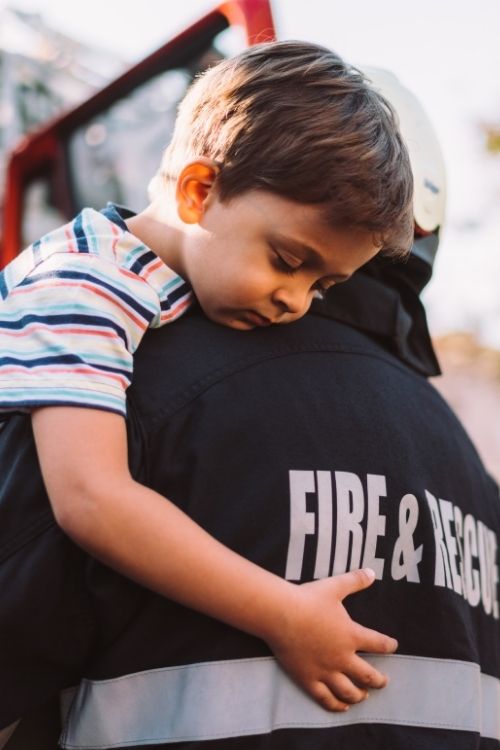Can your kids get out of the house in under 5 minutes?
Emergencies don’t wait for us to plan. Whether it’s a fire, a gas leak, or something else, you might only have seconds to act. Yes, teaching them to get out of the house safely should often come first (and calling emergency hotlines too).
I get it, though. As parents, we hate making our kids worry about “what ifs.” My daughter once heard about her friend’s house being broken into, and she spent weeks scared out of her mind every night. But here’s the thing: empowering them with a plan doesn’t create fear—it builds confidence.

Step 1: Teach the Basics of Emergency Communication
Before anything happens, equip your kids with the information they’ll need to get help once they’re safe. Here’s how to prepare:
Teach Them Key Information: Make sure your kids know your full name, house address, and emergency contact numbers. This is essential for when they need to talk to emergency responders.
Role-Play Scenarios: Look up dispatcher scripts (many are available online) and practice with your kids. Pretend to be the dispatcher, asking real-life questions. Practice helps kids feel more confident and less panicked if they ever have to make that call.
Here’s a fun song for kids about calling 911 to help them remember what to do in an emergency:
Step 2: Simple, Clear Instructions for Leaving the House
In many emergencies, the top priority is to get out of the house as quickly and safely as possible. Kids need clear, easy-to-follow instructions tailored to their age and your home’s layout.
Plan Specific Exit Routes: Walk your kids through the house and show them the best ways to exit from different rooms. Use simple directions like, “If you’re in the living room, go through the front door” or “If you’re in your bedroom, use the window.”
Choose a Safe Meeting Spot: Choose a nearby place where your family will regroup after exiting, or show your kids a place to stay when you’re not home.
This could be a trusted neighbor’s house, like: “See Steve’s house, that’s where you go if something happens and mom and dad aren’t there” or a spot in your yard; for example: “Stand by the big tree in the front yard”.
Practice Evacuating in 5 Minutes or Less: Time your kids during practice drills to make sure they can exit the house quickly.
Step 3: Make It Age-Appropriate
Your instructions should be tailored to your child’s age and abilities. For example:
For Young Kids (4-6 years old): Focus on simple steps, like unlocking doors or climbing out of a low window. Use simple language like “Turn this to open the door” or “Slide this to unlock the window.” Short, sweet, and easy to remember.
Climbing Out of Windows: Show them how to slide or flip the lock, then push the window open. Practice, and maybe throw in a “ta-da!” when they do it.
For Older Kids (7-10 years old): Older kids? They’re ready for a little more responsibility (and probably love showing off how grown-up they are). Sure, start with the basics, but don’t stop there:
Help Younger Siblings: Teach them to guide the little ones once they’re safe—because, let’s face it, they probably already boss them around anyway.
Grab Essentials: Have them practice grabbing a phone or calling for help once they’re safe.
Step 4: Reinforce “Safety First”
Kids often want to grab their favorite toy, their pet, or something important to them in an emergency.
Emphasize the importance of leaving everything behind and prioritizing their safety. Reassure them that their job is to get out first, and you’ll handle everything else.
Step 5: Make It Routine
Emergencies can be chaotic, and even the best instructions can fly out of a child’s mind if they’re panicked. That’s why regular practice is so important:
Monthly Drills: Practice your evacuation plan at least once a month so the steps become second nature.
Change It Up: Simulate different scenarios—like starting in different rooms or pretending the front door is blocked—so your kids are prepared for anything.
Keep It Fun: Turn drills into a game to keep younger kids engaged. For example, challenge them to see how fast they can get to the meeting spot.
Why This Matters
Let’s be real—emergencies are never convenient, and they’re definitely not predictable. Being prepared can make all the difference.
Teaching your kids how to leave the house quickly and safely isn’t just another parenting task, it’s a life skill. You’re giving them the tools they need to protect themselves if the unthinkable happens.
Have a plan and practice it regularly enough for your children to remember. I know it’s hard for parents to imagine their children in situations like this. But let’s do this, not because we want to think about emergencies, but because we love them enough to prepare them for anything.